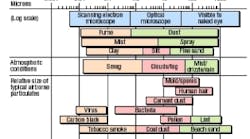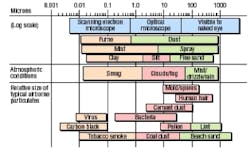He probably told you all you needed to know about changing the oil on your car, but good ol' Dad may never have bothered to tell you why it was so important — not to mention that the clean, new oil you were using could be plenty dirty. In the industrial and mobile worlds, system contamination can shut down expensive processes and fatally damage valuable equipment. A single failure can result in hundreds of thousands of dollars in productivity loss. Contaminants aren't merely a nuisance — they are machinery assassins. So we're here to explain what your father didn't.
1. Know the types of contamination
Typical types of contamination that can threaten hydraulic systems include particulates, water, gases, and bacteria. Combined with these contaminants, conditions of elevated temperatures and flow can lead to further chemical and physical degradation of oils and lubricants. Elevated temperatures accelerate the breakdown of the oil. High flow can lead to electrostatic discharge, also accelerating the degradation of the oil.
2. Find sources of contamination
New oil can be a significant source of contamination. You will likely see a rise in contamination related problems in new oil — in part created by cross contamination issues and also due to the complexity of many of the new additives being used in oils. Ethanol blending at refineries and distribution points, for example, creates water and rust problems for oil and fuel producers. With the water and ethanol come additive separation or degradation issues; all can be potentially harmful and costly to filter out. Recognizing that many of these problems are beyond the control of oil companies, it falls to the consumer to be vigilant to changes in filterability and to clean up new oil before using it.
It has been estimated that 90% of contamination in hydraulic systems could be avoided by a reduction in human error, which allows dust and contaminant ingress. Common mistakes are failure to close filler caps, improper storage of lubricants, failing to filter oil prior to topping off, poor or missing breathers, etc. System-generated wear accounts for only about 10% of most hydraulic system contamination.
Additive dropout is a growing source of contamination that causes premature failure of filters and machinery. The phenomenon can be difficult to detect through chemical oil analysis, but often manifests itself in a sudden increase in filter element clogging. Subsequent filter media analysis — the autopsy, if you will — is likely to reveal S3 (soft sticky stuff) clogging the filter, rarely anything one would closely define as harmful contaminant.
3. Realize the danger of contaminants
Unless they are large enough to settle to the bottom of your reservoir and stay there, unchecked, contaminants will cause big damage. The good news is, you can identify contamination in your hydraulic system and avert disaster.
The most dangerous contaminants are particles that bridge the dynamic clearance in a bearing, typically between 1 and 20 µm in size. This is not to say larger and smaller particles aren't serious — they are! Larger particles, however, are easier to trap; left unchecked they can also be ground down by the system to reach critical and penetrating wear size particles. Very small particles are much harder to capture. Smaller particles can cause sticking of servovalves. They can also agglomerate to reach critical wear particle sizes and act as catalysts for chemical changes in oil. Figure 1 shows relative sizes of different particles.
Water is a particularly difficult contaminant to deal with in oil. It causes chemical corrosion, it can break down oil additives and chemistry, and it generally changes many of the lubrication characteristics of oil. Water and oil, plus a nice warm environment, make a perfect breeding ground for bacteria. Preventing water ingress is the only cost effective control measure. Trying to remove water after it has entered a system is rarely effective and always costly.
Air in the form of bubbles can be entrained in pumps and valves, creating cavitation and catastrophic failure. Small air bubbles also prevent the proper formation of a lubricating film. Highly oxygenated oil will accelerate the chemical breakdown of oil and its additives, building acids, and creating environments for accelerated bacterial growth. Adding diffusers and submerging reservoir returns pipes can do much to reduce this fatal contaminant.
The priority in addressing contamination is preventing their ingress in the first place. Along with good housekeeping, filtration is the most effective method for controlling contaminants in a hydraulic system.
4. Don't forget filtration
Proper filtration is key for reaching and maintaining your desired system cleanliness level.
Understanding filtration processes enables filter manufacturers to make filter media to meet the needs of varying flow rates, viscosity, and efficiencies required by today's sophisticated machinery. There are a variety of filtration mechanisms at work — interception, sieving, intertial impaction, and diffusion. Some of these mechanisms are more effective at capturing particles in air streams, while other mechanisms are better at trapping contaminants in fluid.
This is one of the reasons why a good quality 10 µm absolute filter element will have significantly higher filtration performance when used as an air breather, more in the efficiency range of 1 to 2 µm absolute efficiency.
5. Be aware of your ISO code
The most commonly accepted method of defining cleanliness of a hydraulic system is to use the ISO (International Standards Organization) 4406 code. The code defines how many particles over the size of 4, 6, and 14 µm are present in a sample of oil of known volume. The typical sample size is 1 ml or sometimes 100 ml, and the count is usually expressed as a three-digit number.
For example, to get optimal performance, a hydraulic cartridge valve manufacturer may recommend an ISO cleanliness level of 18/16/13 for their product. To comply with this specification, a 1-ml sample of oil should contain no more than 1300 to 2500 particles greater than 4 µm size, no more than 320 to 640 particles greater than 6 µm in size, and no more than 40 to 80 particles greater than 14 µm in size.
From past experience, we find a typical cleanliness level of new hydraulic fluid to be around 21/20/18. In other words, we could expect to find as many as 10,000 to 20,000 dirt particles larger than 4 µm, 5,000 to 10,000 larger than 6 µm and 1300 to 2500 larger than 14 µm in every 1 ml of new oil. Simplified, in a 55-gal barrel or new oil, you might expect to find 4.2 trillion particles larger than 4 µm! This is a good place to start filtering oil before putting it into working equipment.
Overall, system cleanliness is a function of:
- the initial contamination level,
- filtration efficiency,
- the number of cycles the fluid passes through the filter,
- the contamination ingress rate, and
- the rate of internally generated contamination.
6. Don't make costly mistakes
While the costs of breathers, high efficiency filters, and other contamination control equipment add up, so does the cost of not removing contaminants. For example, a pump circulating hydraulic fluid filtered to ISO 22/21/18 will require less expensive filters than one filtered to ISO 16/14/11. The filters used on the second system will cost more, for sure, but the pump itself (and probably other components as well) will last seven times longer.
7. Remember service intervals
There is a finite life for oil, and there may well be other service related issues other than cleanliness and filter changes that dictate the service interval of a hydraulic system. However, extending service intervals and using higher efficiency filtration can reduce wear dramatically.
This assumes the chemistry of the oil remains viable, which can be verified through oil analysis.
8. Take proper oil samples
Although we recommend extending service intervals, an oil change must be performed periodically. High operating temperatures and arduous working conditions accelerate the end of life of an oil. Monitoring oil condition is necessary to determine a safe operating service interval. Most commercial oil sampling laboratories offer both ISO cleanliness data and chemical spectra analysis. Both are important when determining optimum service intervals.
Chemical degradation of the oil is determined by comparing an oil sample against a known sample of new oil. Changes in cleanliness should be determined by looking at changes of ISO cleanliness levels over time. It is important to understand both data sets. For example, a report showing signs of high wear metal levels, yet no significant increase in particle counts, may be a sign of chemical degradation of the oil. However, a report showing high particle counts, yet low metal wear components, may be an indication of the formation of S3.
It is also important to take a sample when starting up a new system, continue taking samples at regular intervals, and plot the data against time. Only when you have confidence in your maintenance program should your sampling frequency be reduced. Remember that a single oil sample represents a single point on a graph and gives no indication as to the effectiveness of cleanliness program.
Conclusion
Prevention is always better than a cure and is highly effective in keeping hydraulic systems operational. Prevent the ingress of contaminants by human error and embark on a planned contamination control program to eliminate all sources of contaminants, including filtering new oil.
Address particulate, water, gases, and bacteria — the common problems that damage the oil and ultimately the components of the hydraulic system. A regular program of oil sampling and analysis is a critical defense against contaminants; once identified by oil analysis, appropriate actions should be taken to remove them. We're sure that Dad would agree.
Philip Johnson is the global director of liquid product development at Donaldson Co., Minneapolis.



